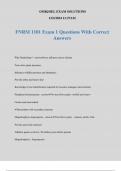©SIRJOEL EXAM SOLUTIONS
12/3/2024 11:27AM
FNRM 1101 Exam 1 Questions With Correct
Answers
Why Dendrology? - answer✔trees influence micro-climate
Trees drive plant dynamics
Influence wildlife presence and abundance
Provide urban and rural value
Knowledge of tree identification required for resource managers and scientists
Pinophyta-Gymnosperms - answer✔•No true flower parts -strobili and cones•
Ovules and seeds naked
•Oldest plants with secondary structure
Magnoliophyta-Angiosperms - answer✔•True flower parts - stamens, pistils, fruit
•Ovules and seeds enclosed
•Modern genera evolved ~50 million years before present
Magnoliophyta - Angiosperms
, ©SIRJOEL EXAM SOLUTIONS
12/3/2024 11:27AM
Liliopsida- Monocots - answer✔Palms, grasses
Typically: 1 cotyledon
Parallel venation
Flower parts in 3's
Vascular bundles scattered in stem
Magnoliophyta - Angiosperms
Magnoliopsida - Dicots - answer✔Walnuts, elms, cashews, beans
Typically:2 cotyledons
Pinnate or palmate leaf venation
Flower parts in 4's or 5's
Vascular bundles in a ring arounda central pith
Tree - answer✔A tree is often described as a plant with a single, woody, perennial stem that
attains a height of over 20 feet at maturity. (or 13 feet, or 15 feet, etc)
shrub - answer✔Shrubs are often described as multi-stemmed, woody, perennial plants that
seldom exceed 20 feet in height.
Vines - answer✔The term vine (lianas) is usually reserved for perennial, climbing, woody
plants... This class of plants usually requires support for upright growth.
, ©SIRJOEL EXAM SOLUTIONS
12/3/2024 11:27AM
names - answer✔Names- scientific and common names; family
form - answer✔Form- tree or shrub
range - answer✔Range- roughly where is it located?
Morphological traits - answer✔Morphological traits - how to identify it
Silvical traits - answer✔Silvical traits - reproduction frequency and method, site requirements,
growth rate, wood strength etc
Uses - answer✔Uses- ecological, economical, cultural
Common associates - answer✔Common associates - other species growing with it
Insects and diseases - answer✔major impacts
Family Magnoliaceae - answer✔•Most ancient of Angiosperms
•7 genera and 220 species worldwide
•2 genera and 9 species native to N. America
•Botanical features of the family
•Leaves: deciduous or persistent, alternate, simple, stipulate
•Flowers: large, showy, solitary, perfect (rarely unisexual)
•Fruit: conelikeaggregate of follicles or samaras
, ©SIRJOEL EXAM SOLUTIONS
12/3/2024 11:27AM
Magnolia acuminata - cucumbertree - answer✔-Leaves: deciduous, alternate, simple, ovate (4-
10" long; 3-6" wide), entire, acute to acuminate.
Flowers and fruit: flowers greenish yellow (1.5 -3.5" wide), fruit a follicle resembling a
cucumber (1.5-3" long) producing 10-60 seeds in red leathery casings.
-Twigs:moderately stout, reddish brown, terminal buds large, silver and silky.
-Bark:brownish grey with narrow flaky ridges.
-Range:Lake Ontario to central LA, eastern OK to central VA.
-Size:Large, relatively short-lived tree to 150 yrs, reaching 100 feet and 36-48 inchdbh(max),
pyramidal crown with straight, clear, slightly buttressed bole.
-Reproduction:perfect flowers, insect pollinated. --Site:moist, fertile soils on bottomlands and
north and east slopes, associates include other hardwoods i.e., white and red oaks, hickories,
black tupelo, beech, ashes, tuliptree.
-Shade tolerance: mid-tolerant of shade
-Economic importance: a soft hardwood, used like tulip-poplar, interior parts on furniture,
interior trim, doors, boxes, pallets, horticultural uses due to flowers.
-Ecological importance: seeds readily eaten by birds and small mammals.
Magnolia grandiflora - southern magnolia - answer✔-Leaves: persistent (2 yrs), alternate,
leathery, ovate, entire, acute, bright green and lustrous above, green and rusty tomentose below.




